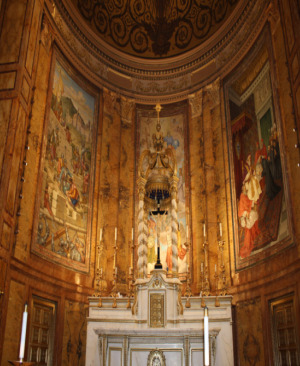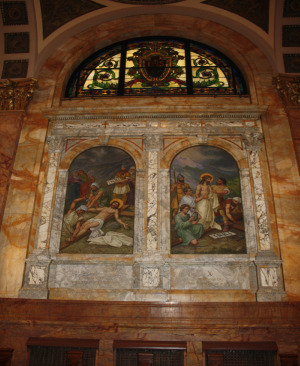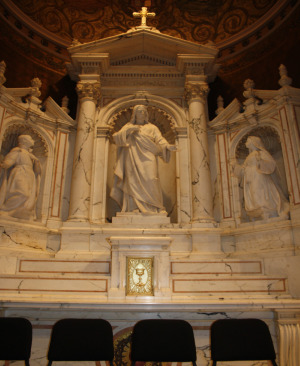‘All for the Greater Glory of God’
Travel Feature: St. Ignatius of Loyola Church in New York City

Ad Majorem Dei Gloriam, Latin for “All for the Greater Glory of God,” is carved right below the pediment on the front of the Church of St. Ignatius Loyola in Manhattan.
It’s more than the motto of the Society of Jesus. It describes the interior beauty of the liturgical art and architecture.
On a recent visit to New York City, my wife, Mary, and I found the limestone church with its classic architecture looking every bit the solid anchor of its upper Park Avenue neighborhood. It was dedicated in 1898 after replacing the church originally founded in 1851 as St. Lawrence O’Toole Church. But in 1866, the parish was entrusted to the Society of Jesus, and the new St. Ignatius of Loyola has been in the care of the Jesuits ever since.
Besides spiritual well-being, the care included a major restoration that was completed a year ago, which again highlights the surprising spiritual drama of the interior.
The vestibule is exceptionally beautiful, with intricate gilt decoration, a life-size stained-glass portrait of St. Ignatius, whose feast day is July 31, and subdued gray and pink marble. It’s a heavenly anteroom for the beauty inside.
Baroque Masterpiece
The church itself is a masterpiece. Marble decorates walls up to the 70-foot-high barrel-vaulted ceiling. White marble abound in the sanctuary and side altars. Gleaming brass shines like gold. Huge mosaics cover the space.

With the sanctuary 160-feet away as the main focus, practically everything else is visible in one sweeping view because of the church’s basic Roman basilica design. The German Baroque style, with all its classic lines and elaborate intricacies, is considered one of the most illustrious designs of William Schickel and Ditmars, a firm that concentrated on churches and related edifices. This one is on the National Register of Historic Buildings.
The design creates a tremendous sense of awe as we walk up the aisle toward the sanctuary. The nave walls are covered with murals of the Stations of the Cross. Each scene is done in marble mosaics so finely colored and highly detailed that they look like paintings by Europe’s Old Masters. The sky even progressively darkens in them as the 12th Station approaches.
The stations appear in pairs, yet are separated and framed elaborately in classic pilasters and arches in different marbles. Designed in Venice, these stations were displayed in Turin before being brought to New York.

Not many churches use marble so profusely, and in such an array of color: red, yellow, gray, green, pink and white.
The white marble gives a glorious appearance to the sanctuary, the main altar, huge triptych side altars, and the full Communion rail stretching across the sanctuary’s width.
The majestic original altar, with its highly polished bronze outlines that gleam in golden brilliance, has the original tabernacle. Above it stands a crucifix beneath a baldacchino supported by white Bernini-like white marble columns with ascending spirals of glowing brass vines.
St. Ignatius
The curved apse presents three main events in the life of St. Ignatius. These huge murals of colorful Venetian glass mosaics resemble Renaissance paintings and are by the same company that crafted the Stations of the Cross. The scenes show Ignatius wounded in the battle that prompted his conversion, kneeling before Pope Paul III in 1540 to get approval for his new order, and receiving acclamation in heaven at his canonization.
Ignatius appears again in a very large stained-glass window in the shallow transept by the Blessed Mother altar. The scene pictures him kneeling before Our Lady holding the Child Jesus as they inspire the saint in writing his Spiritual Exercises, which are still used on retreats today.
Sacred Heart and the Saints
In the opposite transept by the Sacred Heart altar, one stained-glass window shows Jesus appearing to St. Margaret Mary Alacoque.
The great Sacred Heart altar itself reminds us of the devotion because of its triptych style with the side wings that present St. Margaret Mary in one and her Jesuit spiritual director, St. Claude de la Colombiere, in the other.

The altars and images are all white Pavonazzo marble. So is the matching Blessed Mother triptych altar in the other transept, where Our Lady, holding the Child Jesus, is flanked by the Archangel Gabriel and the Prophet Isaiah.
Among the images in the church are marble statues of Jesuit saints. Ignatius’ friend St. Francis Xavier stands heroically in Carrarra in the sanctuary. There are also Society of Jesus patrons of youth: the young Sts. John Berchmans, Aloysius Gonzaga and Stanislaus Kostka. They stand in a highly decorated altar at the rear of the nave, opposite the baptistry which is also the stunning chapel of St. John the Baptist.
In it, rich marble mosaics capture scenes from the Baptist’s life and ministry and present the Lamb of God on the tabernacle door. The liturgical art is after the Florentine Renaissance masters, offering symbols related to baptism, including a dove signifying the Holy Spirit.
The mosaics in this altar were designed by Tiffany’s ecclesiastical department and made of their delicate Favrile iridescent glass.
Joyful Music
Hearing the church’s Mander organ during Sunday high Mass leaves no doubt why the organ is the queen of church instruments.
With more than 5,000 pipes, it’s the largest tracker (mechanical action) pipe organ in New York City and the largest ever built in Great Britain. The pipes and case, made from 18th-century French oaks, reach to the high barrel vault.
While it is used for several concerts each year in the church’s sacred music series, it is mainly played for Masses and accompanies the church’s acclaimed professional choir.
Carved on the organ itself is the theme we found filling all of St. Ignatius Church: Ad Majorem Dei Gloriam.
Staff writer Joseph Pronechen is based in Trumbull, Connecticut.
Planning Your Visit
The Church of St. Ignatius Loyola
980 Park Ave., corner 84th St., in Manhattan, straight up from Grand Central Station
For information, call (212) 288-3588 or visit StIgnatiusLoyola.org for Mass times and details from a pictorial history and walking guide by Jesuit Father Paul Tabor.












